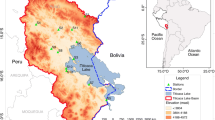Abstract
The reference evapotranspiration (ET0) plays a significant role especially in agricultural water management and water resources planning for irrigation. It can be calculated using different empirical equations and forecasted by applying various artificial intelligence techniques. The simulation result of a machine learning technique is a function of its structure and model inputs. The purpose of this study is to investigate the effect of using the optimum set of time lags for model inputs on the prediction accuracy of monthly ET0 using an artificial neural network (ANN). For this, the weather data time-series i.e. minimum and maximum air temperatures, vapour pressure, sunshine hours, and wind speed were collected from six meteorological stations in Serbia for the period 1980–2010. Three ANN models were applied to monthly ET0 time-series to study the impacts of using the optimum time lags for input time-series on the performance of ANN model. Achieved results of goodness–of–fit statistics approved the results obtained by scatterplots of testing sets - using more time lags that are selected based on their correlation to the dataset is more efficient for monthly ET0 prediction. It was realized that all the developed models showed the best performances at Loznica and Vranje stations and the worst performances at Nis station. Simultaneous assessment of the impact of using a different number of time lags and the set of time lags that show a stronger correlation to the dataset for input time-series, on the performance of ANN model in monthly ET0 prediction in Serbia is the novelty of this study.










Similar content being viewed by others
References
Alizamir M, Kisi O, Muhammad Adnan R, Kuriqi A (2020) Modelling reference evapotranspiration by combining neuro-fuzzy and evolutionary strategies. Acta Geophys 68:1113–1126
Allen RG, Pereira LS, Raes D, Smith M (1998) Crop evapotranspiration. Guidelines for computing crop water requirements. FAO irrigation and drainage paper 56, Rome
Celestin S, Qi F, Li R, Yu T, Cheng W (2020) Evaluation of 32 simple equations against the penman–Monteith method to estimate the reference evapotranspiration in the Hexi corridor, Northwest China. Water 12(10):2772
Fahimi Nezhad E, Fallah Ghalhari G, Bayatani F (2019) Forecasting maximum seasonal temperature using artificial neural networks “Tehran case study”. Asia-Pac J Atmos Sci 55:145–153
Gaur S, Mittal A, Bandyopadhyay A, Holman I, Singh R (2020) Spatio-temporal analysis of land use and land cover change: a systematic model inter-comparison driven by integrated modelling techniques. Int J Remote Sens 41(23):9229–9255. https://doi.org/10.1080/01431161.2020.1815890
Gavili S, Sanikhani H, Kisi O, Mahmoudi MH (2018) Evaluation of several soft computing methods in monthly evapotranspiration modelling. Meteorol Appl 25:128–138
Ghaderi A, Dasineh M, Shokri M, Abraham J (2020) Estimation of actual evapotranspiration using the remote sensing method and SEBAL algorithm: a case study in Ein Khosh plain, Iran. Hydrol 7(2):1–14. https://doi.org/10.3390/hydrology7020036
Gocic M, Trajkovic S (2010) Software for estimating reference evapotranspiration using limited weather data. Comput Electron Agr 71:158–162
Gocic M, Motamedi S, Shamshirband S, Petkovic D, Ch S, Hashim R, Arif M (2015) Soft computing approaches for forecasting reference evapotranspiration. Comput Electron Agric 113:164–173
Kumar M, Raghuwanshi NS, Singh R (2009) Development and validation of GANN model for evapotranspiration estimation. J Hydrol Eng ASCE 44(2):131–140
Landeras G, Ortiz-Barredo A, Lopez JJ (2008) Comparison of artificial neural network models and empirical and semi-empirical equations for daily reference evapotranspiration estimation in the Basque Country (northern Spain). Agr Water Manage 95(5):553–565
Lucio P, Conde F, Cavalcanti I, Serrano A, Ramos A, Cardoso A (2007) Spatiotemporal monthly rainfall reconstruction via artificial neural network - case study: south of Brazil. Adv Geosci 10:67–67
Mattar MA (2018) Using gene expression programming in monthly reference evapotranspiration modeling: A case study in Egypt. Agr Water Manage 198:28–38
Mehdizadeh S (2018) Estimation of daily reference evapotranspiration (ET0) using artificial intelligence methods: offering a new approach for lagged ET0 data-based modeling. J Hydrol 559:794–812
Minu K, Lineesh M, Jessy John C (2010) Wavelet neural networks for nonlinear time-series analysis. Appl Math Sci 4(50):2485–2495
Mohammadi B, Mehdizadeh S (2020) Modeling daily reference evapotranspiration via a novel approach based on support vector regression coupled with whale optimization algorithm. Agr Water Manage 237:106145
Muhammad MKI, Nashwan MS, Shahid S, Tb I, Song YH, Chung ES (2019) Evaluation of empirical reference evapotranspiration models using compromise programming: a case study of peninsular Malaysia. Sustainability 11(16):4267
Nourani V, Elkiran G, Abdullahi J (2020) Multi-step ahead modeling of reference evapotranspiration using a multimodel approach. J Hydrol 581:124434
Ramana RV, Krishna B, Kumar S, Pandey N (2013) Monthly rainfall prediction using wavelet neural network analysis. Water Resour Manag 27:3697–3711
Shiri J (2019) Evaluation of a neuro-fuzzy technique in estimating pan evaporation values in low-altitude locations. Meteorol Appl 26(2):204–212
Tabari H, Grismer ME, Trajkovic S (2013) Comparative analysis of 31 reference evapotranspiration methods under humid conditions. Irrig Sci 31(2):107–117
Valipour M (2015) Investigation of Valiantzas’ evapotranspiration equation in Iran. Theor Appl Climatol 121(1–2):267–278
Yassin MA, Alazba AA, Mattar MA (2016) Artificial neural networks versus gene expression programming for estimating reference evapotranspiration in arid climate. Agr Water Manage 163:110–124
Availability of Data and Material
The data are available from the corresponding author upon request.
Code Availability
Not applicable.
Funding
No
Author information
Authors and Affiliations
Contributions
Milan Gocic designed the initial research, conducted research, collected data and wrote initial manuscript. Mohammad Arab Amiri applied the selected methods and prepared material for the section Results and Discussion and contributed in terms of improving the written language of the manuscript and checking the overall logical flow of the manuscript. In addition, the authors pointed out necessary comments towards improving the quality of the final manuscript. All authors read and approved the final manuscript.
Corresponding author
Ethics declarations
Conflicts of Interest/Competing Interests
Authors declare that they have no conflict of interest.
Additional information
Publisher’s Note
Springer Nature remains neutral with regard to jurisdictional claims in published maps and institutional affiliations.
Rights and permissions
About this article
Cite this article
Gocić, M., Arab Amiri, M. Reference Evapotranspiration Prediction Using Neural Networks and Optimum Time Lags. Water Resour Manage 35, 1913–1926 (2021). https://doi.org/10.1007/s11269-021-02820-8
Received:
Accepted:
Published:
Issue Date:
DOI: https://doi.org/10.1007/s11269-021-02820-8




